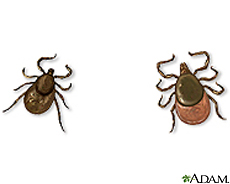National Institutes of Health
- The primary NIH organization for research on Lyme Disease is the National Institute of Allergy and Infectious Diseases
 A service of the U.S. National Library of Medicine
A service of the U.S. National Library of Medicine  National Institutes of Health
National Institutes of Health
Lyme disease is a bacterial infection you get from the bite of an infected tick. The first symptom is usually a rash, which may look like a bull's eye. As the infection spreads, you may have
Lyme disease can be hard to diagnose because you may not have noticed a tick bite. Also, many of its symptoms are like those of the flu and other diseases. In the early stages, your health care provider will look at your symptoms and medical history, to figure out whether you have Lyme disease. Lab tests may help at this stage, but may not always give a clear answer. In the later stages of the disease, a different lab test can confirm whether you have it.
Antibiotics can cure most cases of Lyme disease. The sooner treatment begins, the quicker and more complete the recovery.
After treatment, some patients may still have muscle or joint aches and nervous system symptoms. This is called post-Lyme disease syndrome (PLDS). Long-term antibiotics have not been shown to help with PLDS. However, there are ways to help with the symptoms of PLDS, and most patients do get better with time.
NIH: National Institute of Allergy and Infectious Diseases
References and abstracts from MEDLINE/PubMed (National Library of Medicine)
